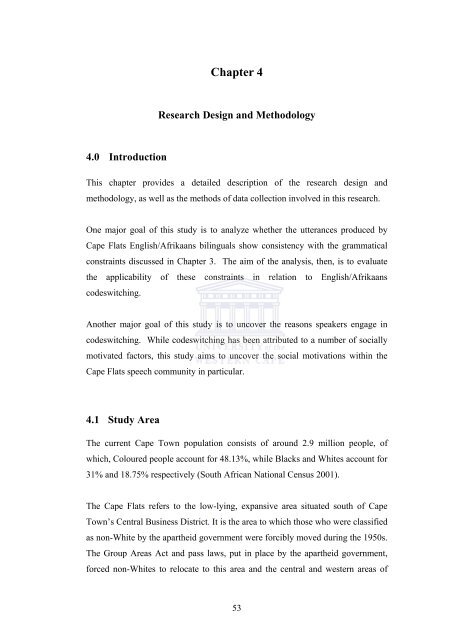grammatical constraints and motivations for - University of the ...
grammatical constraints and motivations for - University of the ...
grammatical constraints and motivations for - University of the ...
You also want an ePaper? Increase the reach of your titles
YUMPU automatically turns print PDFs into web optimized ePapers that Google loves.
4.0 Introduction<br />
Chapter 4<br />
Research Design <strong>and</strong> Methodology<br />
This chapter provides a detailed description <strong>of</strong> <strong>the</strong> research design <strong>and</strong><br />
methodology, as well as <strong>the</strong> methods <strong>of</strong> data collection involved in this research.<br />
One major goal <strong>of</strong> this study is to analyze whe<strong>the</strong>r <strong>the</strong> utterances produced by<br />
Cape Flats English/Afrikaans bilinguals show consistency with <strong>the</strong> <strong>grammatical</strong><br />
<strong>constraints</strong> discussed in Chapter 3. The aim <strong>of</strong> <strong>the</strong> analysis, <strong>the</strong>n, is to evaluate<br />
<strong>the</strong> applicability <strong>of</strong> <strong>the</strong>se <strong>constraints</strong> in relation to English/Afrikaans<br />
codeswitching.<br />
Ano<strong>the</strong>r major goal <strong>of</strong> this study is to uncover <strong>the</strong> reasons speakers engage in<br />
codeswitching. While codeswitching has been attributed to a number <strong>of</strong> socially<br />
motivated factors, this study aims to uncover <strong>the</strong> social <strong>motivations</strong> within <strong>the</strong><br />
Cape Flats speech community in particular.<br />
4.1 Study Area<br />
The current Cape Town population consists <strong>of</strong> around 2.9 million people, <strong>of</strong><br />
which, Coloured people account <strong>for</strong> 48.13%, while Blacks <strong>and</strong> Whites account <strong>for</strong><br />
31% <strong>and</strong> 18.75% respectively (South African National Census 2001).<br />
The Cape Flats refers to <strong>the</strong> low-lying, expansive area situated south <strong>of</strong> Cape<br />
Town’s Central Business District. It is <strong>the</strong> area to which those who were classified<br />
as non-White by <strong>the</strong> apar<strong>the</strong>id government were <strong>for</strong>cibly moved during <strong>the</strong> 1950s.<br />
The Group Areas Act <strong>and</strong> pass laws, put in place by <strong>the</strong> apar<strong>the</strong>id government,<br />
<strong>for</strong>ced non-Whites to relocate to this area <strong>and</strong> <strong>the</strong> central <strong>and</strong> western areas <strong>of</strong><br />
53
















